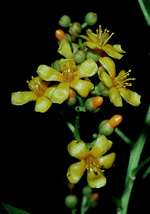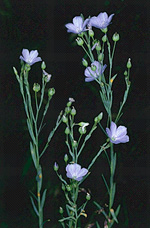 |
This is a small, mainly temperate family represented in Australia by 3
genera from woodlands and open forests in south-eastern Australia, from
southern South Australia to south-east Queensland.
Characteristic features of the family Linaceae in Australia include: - herbs or (Durandea) shrubs or climbers with alternate, simple, entire, often bluish leaves
- flowers bisexual, regular, with 5 free sepals and 5 free or basally fused, spreading, blue, white, yellow or red petals
- stamens 5 or numerous, often with broad-based filaments
- ovary superior, developing into a capsule with relatively large, flattened seeds
Description
Evergreen shrubs, or woody or herbaceous vines climbing by hooks, or annual or perennial terrestrial herbs. Perennating by tubers or crowns. Internal secretions not obvious. Plants glabrous. Leaves well developed, alternate and spiral, cauline if herbs, petiolate, subsessile or sessile. Stipules absent or present and distinct and free from the petiole, bristle-like or gland-like, falling off early. Lamina simple, symmetric, filiform, acicular, subulate, linear, lanceolate, ovate, oblanceolate or obovate; base cuneate or rounded; margins entire or crenate, ±flat; one-veined, or the venation pinnate, with the midrib conspicuous or inconspicuous, and the tertiary venation reticulate or not; surfaces not punctate; herbaceous. Plants with all the flowers bisexual. Inflorescences terminal, consisting of panicles or cymes. Bracts present. Pollination by insects. Flowers stalked. Floral disc present or absent; nectaries absent or present on the perianth. Perianth regular, of 2 dissimilar whorls, imbricate in bud;. Calyx segments free, with 5 sepals. Corolla free or fused, with 5 petals or lobes, alternating with the sepals, bell-shaped, yellow, orange or blue, without contrasting markings, or streaked, spotted, etc, membranous; claws present or absent; lobes ±entire. Fertile stamens 5, 10 or 15, opposite to or not clearly correlated with the sepals, free of the corolla, free of the ovary and style, fused by their filaments into an open or closed tube, all ±equal or distinctly alternating long and short. Staminodes present or absent. Anthers dorsifixed, versatile, opening inwards by longitudinal slits, 2-celled. Ovary superior and sessile. Carpels 5, fused; ovary with 5 locules. Style terminal, single and unbranched, or branching above or from the base. Ovules 2 per locule, stalked; placentation axile. Fruit a dry dehiscent septicidal capsule; the perianth on the maturing fruit deciduous or dry and persistent. Disseminule micro-surface ±reticulate or foveate, orange, brown or grey, glossy. Seeds 10 per fruit. Aril absent. Cotyledons 2. Embryo straight.
(Note: this description has been generated from the coded data compiled for the key. Any errors in the key data will be reflected in the descriptions.)
A treatment of the family Linaceae has not yet been published in the Flora of Australia. It will appear in Volume 24.
Australian genera of Linaceae (as recognised for the Flora of Australia)
† = some species native, others introduced
Durandea
†Linum

|
  |

Hugonia jenkinsii (flowers)
Photo: G.Sankowski © Zodiac Publications

Linum marginale (flowers)
Photo: M.Fagg © M.Fagg
|
 |
|